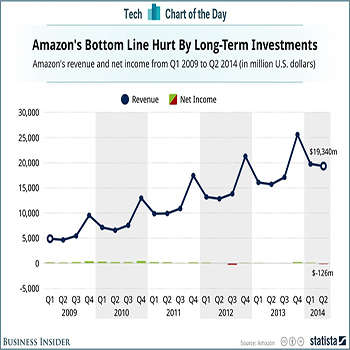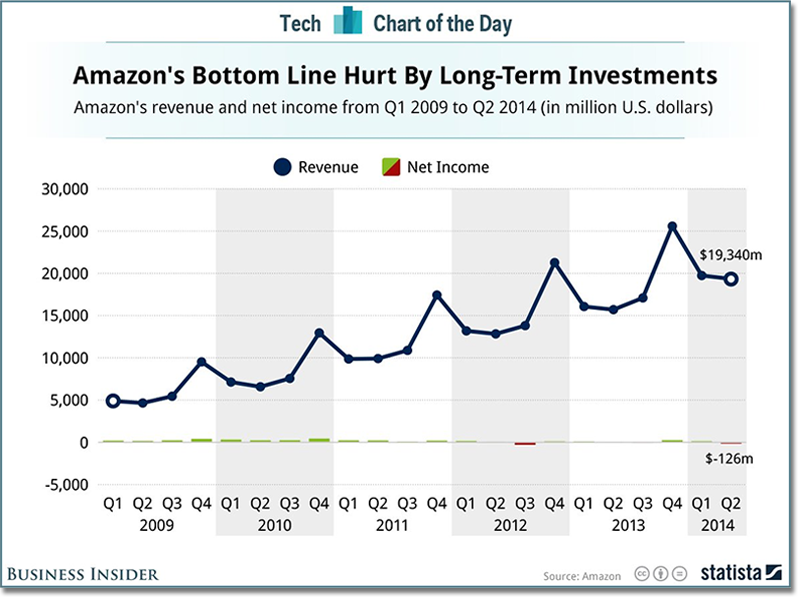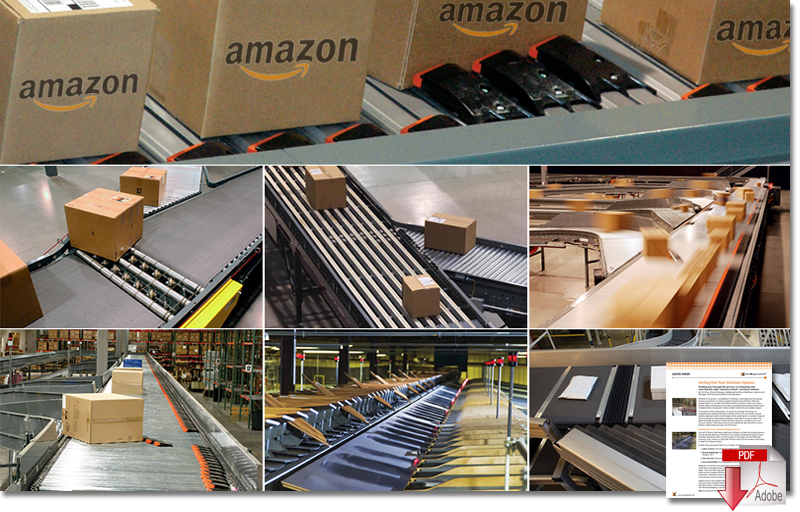Why Amazon is Losing $410 to $810 Million this Quarter

Amazon's stock is tanking after the company delivered disappointing second-quarter earnings, including enormous predicted losses for next quarter.
In a press release, Amazon said that about $410 million of that would go to stock-based compensation, but what about the other potential $400 million?
In Amazon’s earnings call, CFO Tom Szkutak described several major contributors to the expected losses: Investment in Amazon Web Services, digital content, and the development of new fulfillment and “sortation” centers.
Szkutak says that AWS usage grew by 90% year over year and that the company plans on continuing to invest heavily. This year, Amazon released 250 new services and features. It also gave users more discounts (just days after Google cut prices for its cloud services earlier this year, Amazon slashed its own prices, proudly touting its 42nd price cut in six years).
Szkutak also said that the company planned to spend more than $100 million on original video content in the third quarter. Amazon wants to beef up its Prime Instant Video content to make its $99 Prime subscriptions more attractive to potential members. The more people who sign up for Prime, the better for Amazon. (People with Prime spend almost double the amount on Amazon as nonmembers.)
Finally, on its constant quest for speedier delivery, Amazon is adding six fulfillment centers and 15 or more “sortation” centers. The point of sortation centers is to make shipping more efficient (see below - Amazon’s ‘Sortation Centers’ Bite Off More of Delivery’s ‘Last Mile’).
Amazon sends prepared customer packages to sortation centers, where they’re then sorted and shipped to individual post offices, which Szkutak says helps get product to customers faster and on Sundays. (Amazon now delivers on Sundays to 17 cities.)
Despite Szkutak’s explanations, investors on the call still seemed skeptical. Although they’ve typically accepted Jeff Bezos’ mantra of taking losses now for long-term success, the stock plunge is clearly an indicator that they’re running out of patience.
Most Of Amazon’s Income Goes Back Into The Company
Amazon reported its earnings Thursday, but while revenues were right in line with Wall Street’s expectations, the company posted a net loss of $126 million. The company says it will lose between $410 million and $810 million in the next quarter, compared to just $25 million in the quarter a year ago.
When you look at Amazon’s revenue and income data, which was charted for us by Statista, Amazon rarely posts big profits, as the company continually re-invests its net income back into the company. It may not be great for the company’s bottom line, which might explain all of the company’s fleeing investors, but at least Amazon’s revenue keeps steadily growing each year. Already this year, Amazon has unveiled two new consumer devices, including a TV set-top box and a 3-D smartphone called “Fire,” but breaking into new product categories isn’t cheap.
Amazon’s ‘Sortation Centers’ Bite Off More of Delivery’s ‘Last Mile’
Amazon.com is taking more control of its delivery operations, a move that will likely give it an edge in same-day delivery options and bolster its challenge to traditional brick-and-mortar retailers.
The company recently opened up a new “sortation center” in Kent, Washington, the Seattle Times’ Jay Greene reports. Unlike traditional fulfillment centers where employees sort and prepare items for shipment, this warehouse is full of sealed packages that move along conveyor belts, where workers and computers sort them and prepare to ship them to individual post offices.
Increasing delivery speed is a top priority for Amazon, Mr. Greene writes. By controlling the delivery process up to the last mile, Amazon can deliver packages to customers on Sunday, a service it announced last year. The sortation centers can also help Amazon reduce shipping costs, and brings the company closer to erasing brick-and-mortar’s key advantage: the ability for customers to immediately walk away with the item they purchased.
Control is key for Amazon, particularly after last year’s holiday season, when the company faced delivery delays from UPS that left some customers without their gifts. At the time, analysts said there was plenty of blame to go around for the mishap, including on retailers for setting unrealistic delivery expectations. Amazon, for example, told customers as late as Dec. 22 that they could still get gifts in time for Christmas. The last-minute orders led to a shipping bottleneck and late gifts.
Related: How Online Consumers Added to the Holiday Shipping & Logistics Nightmare
Amazon has quietly opened up more of these centers in Atlanta; Dallas; Houston; Phoenix; Avenel, N.J.; Hebron, Ky.; and San Bernardino, Calif., the Seattle Times writes.
Here’s how the sortation center works:
In the past, Amazon might have shipped a DVD ordered by a Seattle shopper, for example, from its fulfillment center in Sumner. There, workers would have boxed the item and handed the package off to one of several carriers, such as UPS or FedEx.
Now, Amazon will put that DVD onto a truck that will bring it, along with tens of thousands of other packages on other trucks to this Kent site, generally within a day or so for items that are shipped two-day delivery.
Amazon workers, then, sort all the packages by ZIP codes, place them on pallets and deliver them to local post offices — for now, the new sortation centers will deliver only to U.S. Postal Service offices — by 6 a.m. to 8 a.m. to arrive in that day’s mail.
Amazon has also been testing its own delivery network for the “last mile” of a package’s journey to customers’ doorsteps, according to the WSJ. Trucks loaded with Amazon packages and driven by Amazon-supervised contractors leave for addresses around San Francisco, and similar efforts are under way in Los Angeles and New York.
Speedier delivery by Amazon is yet another challenge to brick-and-mortar retailers still grappling with their e-commerce and fulfillment efforts. As more technology companies, including Google Inc., get into the delivery business, these retailers will need to find a way to optimize their own e-commerce and shipping offerings to best meet customers’ needs.
Related: Why Amazon’s $8Trillion B2B Bet is Flying Under the Radar Screen
Article Topics
Honeywell Intelligrated News & Resources
Southern Glazer’s Wine & Spirits: Proof positive innovation Southern Glazer’s Wine & Spirits: Proof positive innovation Time to integrate those robots Empower Your Automation Journey at ProMat 2023 Conveyors and sorters surge ahead Raise Your Operational Intelligence Report: Automation “a Matter of Survival” More Honeywell IntelligratedLatest in Supply Chain
Microsoft Unveils New AI Innovations For Warehouses Let’s Spend Five Minutes Talking About ... Malaysia Baltimore Bridge Collapse: Impact on Freight Navigating TIm Cook Says Apple Plans to Increase Investments in Vietnam Amazon Logistics’ Growth Shakes Up Shipping Industry in 2023 Spotlight Startup: Cart.com is Reimagining Logistics Walmart and Swisslog Expand Partnership with New Texas Facility More Supply Chain















